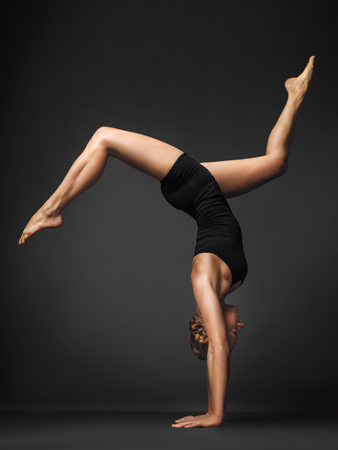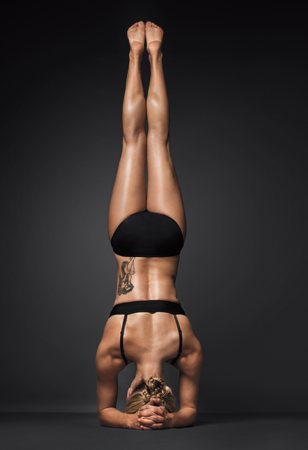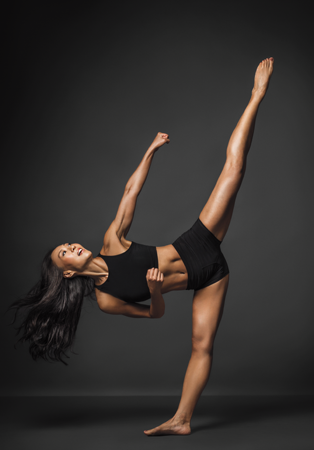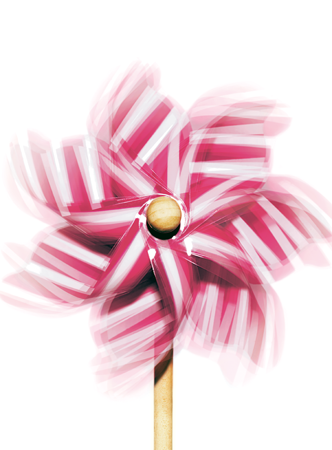
CHAPTER 2
Balancing Your Body

There’s a modern myth that if we just keep going and going and going—sleep be damned!—our bodies will continually recover, like starfish regenerating limbs.
In real life, alas, our bodies register that wear and tear. Sure, we feel invincible in the moment as we knock off everything on our to-do lists (thanks, adrenaline!). But eventually, even the hardiest of us will start to break down.
You just know when your body has had enough. Maybe you aren’t sleeping right. Your skin is acting up. You’re having one too many wine-and-bar-food nights and not enough eat-clean-and-retire-early nights. Suddenly, without an injury, your back aches.
Stress symptoms like headaches and stomach issues are no fun, but they’re your body’s way of warning you: Hey, lady, slow down. Heed them and minor symptoms are less likely to turn into lasting health problems.
When your body is in balance, you just have an edge. A good night’s sleep—generally defined as seven hours most nights—strengthens your immune system; it also helps with weight control. Eating a nourishing diet does more than keep you from getting hangry (as in hungry + angry)—it delivers the right mix of nutrients so you have the energy to get through every part of your day.
As you’ve surely heard, getting regular exercise is also key. Working in a mix of cardio and strength at least five days a week not only reduces stress but also helps keep you healthy long term. Women who do vigorous exercise have a 17 percent lower risk of premenopausal breast cancer, according to a recent review of 100 studies conducted by the American Institute of Cancer Research and the World Cancer Research Fund. Even doing moderate exercise, the report concluded, cut a woman’s chances of getting postmenopausal breast cancer, the most common type. Strength moves also matter: They bolster your bones and let you burn more calories at rest (read: speed your metabolism).
Best part? There’s no need for an extreme health kick. When it comes to being kinder to your body, regular baby steps make a big difference.
The New Rules of Eating for Energy
Fuel up the right way to stay juiced all day and keep your mood steady.
By Mandy Oaklander
There’s no better feeling than being on a good-eating streak. Feeding your body the proper fuel has an immediate effect; on days you eat right, you can somehow spring out of bed in the morning, stay sharp through every meeting and remain focused, productive and on your A game.
Lots of people, however, are familiar with a much different chain reaction. Just a few straight days of eating processed, sugary foods can leave you lethargic before the workday even starts. Participating in meetings? Rain check. Focus? Forget about it. Your primary goal for the day is to resist the temptation to curl up into a ball and take a nap.
Which kind of day you have depends largely on the food you feed yourself. The good news is that it’s easy—and delicious–to eat for optimal energy, as long as you plan for it. If you fuel up in a balanced way, you’ll have the juice to keep going all day without any afternoon energy slumps. The trick to all-day energy isn’t swallowing one particularly magical superfood, but eating the best foods at the right times. Check out the new thinking on powerful eating.
1. Eat protein for breakfast
If every morning begins with your rushing out the door instead of sitting down at the table—and then finding yourself hungry before lunch—make some space for breakfast.
But the type of morning meal you eat matters just as much. One study found that people who ate breakfasts high in protein (about 30 grams) with low glycemic loads—meals that keep blood sugar levels low and stable—had the highest energy levels. Another study published in the American Journal of Clinical Nutrition discovered that those who had lots of protein in the morning were more satiated and ate fewer fatty foods at night than those who ate cereal for breakfast, or nothing at all.
Why? Protein takes longer to digest than refined carbohydrates, so you’ll feel fuller, longer. Instead of cereal or a muffin, try an egg, a cup of milk, a handful of walnuts, and a whole-grain English muffin. For another option, sprinkle walnuts, almonds, and seeds into a bowl of oatmeal, and pair it with a glass of soy milk on the side.
2. Drink water
Forget those chemical-laden caffeine concoctions: The best energy drink is H2O. Without enough of it, dehydration sets in, and one of the first symptoms you’ll notice is fatigue.
Drinking water throughout the day—about 11 to 13 cups total (that includes the water found naturally in foods and drinks)—will help optimize energy levels. Sip more when you work out, since you lose water through breathing and sweating. You’ll know you’re getting enough when your urine is almost clear.
3. Don’t shy away from snacking
Snacking gets a bad reputation, but it’s a great way to prevent overeating. A simple way to gauge the amount of energy in your tank is to ask yourself if you’re hungry. If you are, then eat. “Staying not hungry, so you don’t overeat all at once, is a good thing,” says Michael Roizen, MD, chief wellness officer at Cleveland Clinic’s Wellness Institute. Choose munchies with fiber, protein, and a bit of healthy fat to keep you feeling full—like a handful of almonds or veggie chips and hummus.
4. Eat smaller meals—but make your main meals earlier
Big meals are energy zappers. (Just ask anyone who’s tried to resist a nap after a burger-fries-and-shake lunch.) Cutting down the size of your meals will help you power through the day instead of succumbing, and there’s a reason for that. “If you eat too-big meals, you will devote too much blood flow to your intestine and not have enough to feel energized,” Roizen says. “That’s the usual grogginess after the Thanksgiving meal.” Overloading your plate has also been shown to damage mitochondria, the body’s tiny powerhouses of energy.
One promising way to optimize your energy is to eat more calories earlier in the day. “The way they eat in Europe—a moderate-size meal for breakfast and lunch and small meal for dinner—is probably correct,” Roizen says. “That’s because your body processes meals earlier in the day better than it does later in the day, based on your food circadian rhythm and hormonal changes.”
5. Don’t turn to sugar
Though sugar packs a ton of energy—calories, in science-speak—it won’t give you the type that lasts. Simple refined carbohydrates, like doughnuts, pastries and white pasta, break down fast in the body and quickly turn into blood sugar; shortly after an initial blood sugar spike, you’ll be left feeling drained. The easiest way to have more energy is to cut these out and add complex carbohydrates, which are found in beans, whole grains, and vegetables. These break down more slowly in the body and keep energy levels balanced, so you’ll skip the energy dips and be satisfied for longer. Plus, you’ll get the vitamins, minerals, and fiber that refined sugars are missing.
6. Go ahead, have another cup of coffee
If coffee makes you anxious or nauseous, or if your heart starts racing after your first cup, then skip it. But if you, like most Americans, drink at least one cup of joe per day, then you’ll love what the latest research has to say about coffee. Java drinkers have been shown to have a lower risk of type-2 diabetes, stroke, several kinds of cancer, inflammation, and even early death than those who don’t drink it. Scientists don’t know why quite yet, but coffee is high in antioxidants—it’s the number-one source of them for Americans—and those compounds help fight cancer-causing oxidative damage. Coffee even offers an extra energy boost before exercise; recent research shows that drinking coffee before a workout can help it feel easier and less painful.
“Caffeine will increase your metabolic rate consistently, which is what most of us call energy,” Roizen says. “You’re able to do a little more at all times.” Studies have shown that drinking up to four 8-ounce cups per day is safe. Just make sure you cut yourself off by late afternoon or else your buzz may blow your night’s sleep.
7. Dine with your friends
Inhaling lunch at your desk might seem like a productivity shortcut, but taking a break to eat with friends or coworkers face to face will brighten your day—and your spirits, too. Social interaction has been shown to help people manage stress, pain, and sadness, all of which are big drains on energy.
Social lunches do have one downside, however. Research has shown that eating with friends can make people so comfortable—or so vulnerable to the eating habits of others—that they overeat. Thankfully, a friend’s health kick can also be contagious. One study review, published in Appetite, found that children exposed to parents’ and peers’ healthy eating were more likely to eat their veggies. It works for grown-ups, too: Dine with that friend who orders salmon and quinoa and you’ll be more likely to crave a clean meal.
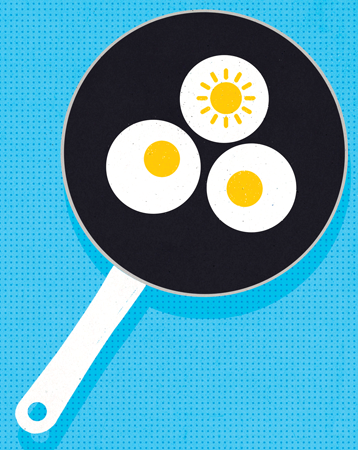
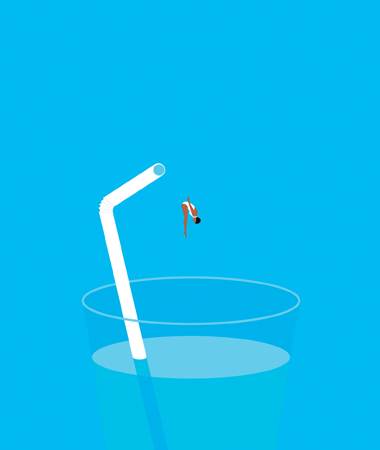
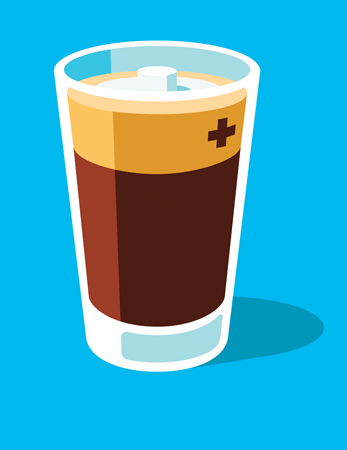
Snack Smarter
The ideal snack has fewer than 250 calories, about 3 grams of fiber, 5 grams of protein, and no more than 12 grams of fat.
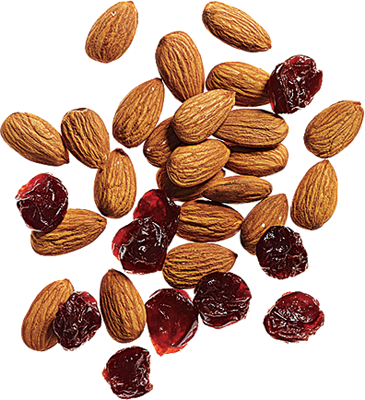
almonds mixed with dried cherries or blueberries
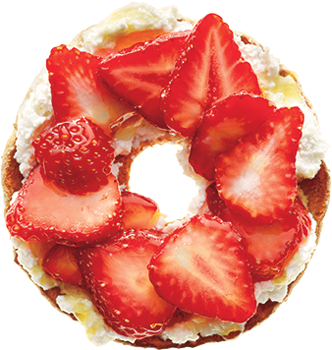
half a whole-grain bagel with ricotta and strawberries
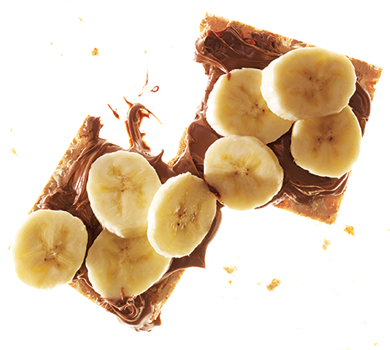
crackers with chocolate-hazelnut spread and banana
Mindful Drinking
Between date night, girls’ outings, and work drinks, it’s easier than ever to go accidentally overboard. Our writer sits in on a unique class that teaches a more thoughtful approach.
By Julie Klam
A few years ago, I noticed a trend among the people I socialize with. Instead of suggesting we meet for coffee, it was “Let’s get drinks!” Maybe this was because I was hitting a phase in my life where many of my friends were also divorced and therefore had some nights “off.” Or it might have been that drinks just sound more festive than coffee…and don’t we all need more festivity? Even though I’ve never been that much of a drinker—you can always spot me at the table, the one with five ice cubes in my white wine—I found myself having drinks out a lot.
My problem is, I tend to drink the way I shop and write: fast. Of the three, drinking fast is the only one that gives me trouble. Shopping fast gets you a good white shirt in under 20 minutes, but swigging drinks gets you a following morning filled with regrets. It makes it harder to realize when your slight buzz is turning into an “Oops, I’m drunk.” I don’t abuse alcohol, but I have had vague thoughts about whether I should reframe my relationship with it.
Enter the theory of mindful drinking. It is, as its name indicates, a conscious approach to consuming alcohol. The technique has become popular in the U.K., where a group called Club Soda teaches the approach and hosts mindful-drinking pub crawls; the organization produced its first Mindful Drinking Festival in 2017. Research shows there has been a rapid decline in drinking among young people across Britain.
Moderation Movement
Though it sounds trendy, mindful drinking has long been practiced by Buddhists, says Lodro Rinzler, author of the millennial life guidebook The Buddha Walks into a Bar. Buddhist monks usually can’t have alcohol or other intoxicants, he explains, “but lay practitioners today are not expected to cut out those things in the same way. In fact, in the Tibetan Vajrayana tradition, there’s an emphasis on taking things normally viewed as obstacles as part of the spiritual path, which happens to include alcohol in some ceremonies.”
And many Americans in 2017 seem to prefer an all-or-nothing approach to alcohol. “All”—well, we know what that is. Drinking to excess increases your risk of certain diseases, such as breast cancer and dementia, as well as dependence. And the number of women who say they’ve had a heavy-drinking day at least once in the past year is at an all-time high, according to the National Institute on Alcohol Abuse and Alcoholism. Only 30 percent of women who drink stay within what NIAAA defines as “low-risk” limits, which in women is no more than three drinks on any given day and no more than seven per week. The Mad Men era brought us men swigging boilermakers at noon; in the current era, women are equally comfortable with their cocktail intake, and females’ patterns of alcohol use and abuse have grown to look more like men’s, according to NIAAA research. Look to the myriad social-media posts of “Boozy brunch!” and “Wine o’clock!” Or to the philosopher of our time, the Pinterest board, bulging with cocktail-centric memes (“Sorry I’m late…I like to arrive fashionably drunk”).
As for the “nothing,” it comes in forms like Whole30, in which people eliminate sugar, dairy, grains, legumes, and alcohol in an effort to scour their systems, or #DryJanuary, where the goal is abstention for one month (January being the month after #DrinkandEatEverythingInSightDecember). Post-cleanse, enthusiasts report how great they feel: clearer-headed and with looser jeans. But for so many women, the results of such drastic change are short-lived. If you enjoy drinking and aren’t addicted but do want to approach it in a healthy way, cleansing isn’t usually a long-term fix.
Rinzler promises a middle path to lasting change. First stop: his MNDFL meditation studio in Brooklyn, New York, where he teaches mindful-drinking classes.
The MNDFL Studio felt more like a spa than a meditation center. No incense-mixed-with-ramen smell, but there were indoor trees and super-flattering lighting. As we settled in on our assigned cushions, I looked around at the other attendees, who were easily 15 to 20 years younger than I am, and wondered where the 40- to 55-year-olds were. Did they not want to drink mindfully, or were they just not up for leaving the house on a Monday night?
Cocktail Consciousness
Rinzler began with a brief history of mindful drinking. Nonmonastic Buddhists wanted to be able to drink comfortably, he said, so they developed the methods that morphed into mindful drinking. “In our newly conscious world, we feel a need for help to drink more responsibly, for ourselves and those we drink with,” he said. “Anyone here ever have an awful next-day feeling after a night of overimbibing?” Quickly he was greeted with a chorus of sympathetic groans. “Come back to me when you’ve been hungover on a class trip to the Bronx Zoo with 40 second-graders,” I thought. But I mindfully opted to remain silent.
He then began the practice, showing us how to take a moment to center ourselves before we went to drink. This could be done in the car on the way to a party or at your place while getting ready to go to a bar. The idea was to clear your mind as much as possible of the stress of the day.
Consider the specifics of the night ahead of you, he encouraged. Whom are you going to meet? What do you want to do? If you’re going to meet friends, think about how you will talk and listen, and be present for the company, and enjoy your drink. By visualizing how you want to be mindful ahead of time, you’re more likely to experience mindfulness when the lights are down, the music is soothing, and the alcohol is flowing.
Rinzler then gave us an opportunity to test his approach, directing us to file into the kitchen reception area to get a rye whiskey with ice and an orange peel. The amber tinge reminded me of whatever Lou Grant had in his desk drawer.
Of course, in real life, Rinzler pointed out, you don’t walk into a bar and get handed a drink. You would mindfully consider the choices. I’ve always been wary of anything new, but I decided that the next time I went to a bar I would try something with subtle flavors and unusual accoutrements. Nothing crazy, but maybe mint!
We returned to our cushions, drinks in hand, and Rinzler instructed us to first feel the drink. How did the glass feel? How about the ice? Then we sniffed the drink and thought about how it smelled. We were told to take a sip and savor it—really concentrate on how it felt, how it tasted, what memories or sensations it evoked.
Right off the bat, I hated this drink. I’m not a whiskey gal, so I didn’t feel like it was a fair test of my self-control. But it was OK: Not loving it helped me pay attention.
Next, we were teamed up to simulate a bar or party scene, because the real challenge comes when you’re in a group. I was matched with two other women, one from South Africa and one from Italy. We told stories of the first drinks we’d ever had (mine was a screwdriver—total baby drink), all the while taking mindful sips. We were instructed to really listen, not listen while thinking of what you’re going to say when the person stops talking. It was hard, but no one said consciousness is easy.
It occurred to me that when I’m in a drinking situation, I’m very aware of “the next drink” and whether I’m going to have it or not. I tend to speed up the one I’m drinking if another round is possible. When I’m drinking this way, I’m not fully present in the conversation and not being courteous to the person I’m with. I felt great relief at this epiphany and more than anything looked forward to being more aware of this with my friends.
We repeated the exercise, this time paired with a new person. We were given the option of having a second drink; I was surprised to realize I still had most of my first one in my glass. But after only a couple of sips, I did notice I was tired and tuning out. Mindfulness requires a lot of mental energy. I felt very ready to go home.
Happier Hour
Over the next week, I practiced Rinzler’s teachings at home. I enjoyed a single beer with my boyfriend one night. The next night, at my monthly potluck dinner, I poured myself a glass of wine and carefully sipped…until a friend came in with pitchers of cosmos and insisted I have one. I had my mindful glass of wine in one hand and my crazy-gals’-night-out cosmo in the other. (Side note: Cosmos are tasty but strong, so if you chug them like Gatorade, you will be drunk, and if you’re drunk, you can’t be mindful.)
I mentioned my experiment to my friend Rosie Schaap, a bartender and author who has written about cocktail culture. “As a server,” she told me, “I’m aware that it’s our responsibility to be mindful as well. Look customers in the eye, ask them how they are, and really mean it. Take an interest in what they are saying.” Rosie told me about Gary (a.k.a. “Gaz”) Regan, also a bartender, who cofounded the global Institute for Mindful Bartending. In one lesson, bartenders are told to make a Negroni, first while thinking about someone they dislike, then with the exact same ingredients but while thinking about someone they love. The second drink is said to taste immeasurably better than the first. Schaap pointed out that with the popularity of craft cocktails, with their fragrant, interesting ingredients and pleasing presentation, mindful drinking is even more satisfying.
All of this is well and good if you’re able to do it. If you have concerns about alcoholism, then any drinking, whether mindful or not, is ill-advised. Mindful drinking, says Rinzler, “is for people who want to have a healthy relationship with alcohol, but it’s no substitute for a recovery program. It’s born of a more pedestrian desire to change our relationship to something in our life, in the same way we might want to reevaluate our relationship to technology.”
As someone who’s been through a mindless drinking phase and now Rinzler’s session, I realize my evenings are vastly improved with these new tools. More than once after a night out, I’ve felt a twinge of guilt—not for drinking too much but for forgetting to feel my drink or smell it or something. But there’s no question I feel physically better the next morning. It’s lovely to slow down and savor our drinks and our precious time with friends. And to realize that this mindful approach just might help me make more of life’s other pleasures as well.
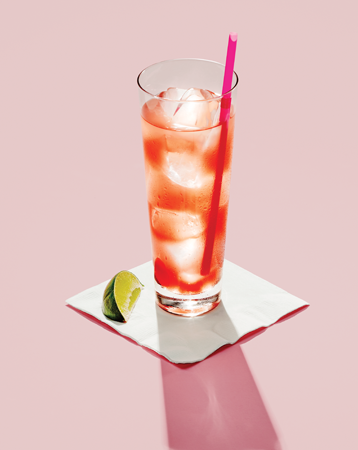
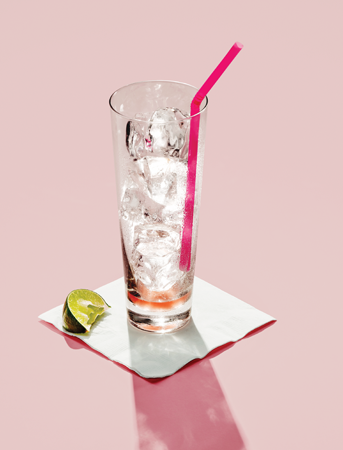
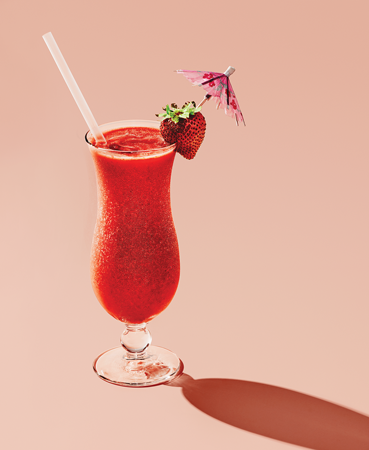
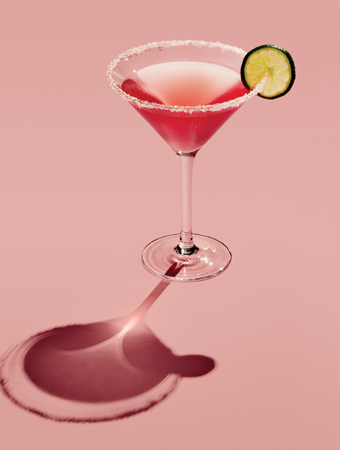
Sleep Like You’re on Vacation
Want more rejuvenating shut-eye? Our insomniac writer flew across the world and came back with some life-changing strategies.
By Valerie Frankel
I should have been excited for my upcoming trip to Fiji—and I was—but as a chronic insomniac, I was worried about not getting any shut-eye while I was there. I was especially nervous about the long flight, so I packed sleeping pills. When the pilot dimmed the cabin lights, I reached into my backpack for one of my little helpers—but I couldn’t find the pill vial. Without my crutch, I fretted and sweated for the entire 10-hour flight, anxious that my insomnia would ruin my vacation. There was no corner Rite Aid in the South Pacific. Much to my shock and relief, though, I slept well while away. The first night was touch and go. But by the third, I floated off to dreamland on a coconut cloud and woke up as refreshed as the smiling, white-camisole-clad ladies in the mattress ads on TV.
I credited the healthy Fijian diet of fish and fruit for my new talent for nodding off. But a friend told me she’d experienced a similar phenomenon while in Paris eating foie gras and cheese. “Apart from caffeine and alcohol, diet doesn’t strongly influence sleep,” says Kelly Glazer Baron, PhD, assistant professor of neurology and director of the Behavioral Sleep Medicine Program at Northwestern University. I hadn’t given up coffee, so how to explain my miracle transformation? According to experts I quizzed afterward, several things I did on my trip likely improved my sleep—and they’re habits you can steal to snooze more soundly in your own room.
Change Up Your Surroundings
Unfamiliar beds can give good sleepers a bad night, but for insomniacs, they can blunt the worry that contributes to sleeplessness. “The mattress and sheets are different from what you’re used to, so you don’t associate them with staying awake like you might at home,” says Robert Oexman, a chiropractor and director of the Sleep to Live Institute in Joplin, Missouri. In Fiji, I also enjoyed silence—a pleasure lacking amid the sirens in my Brooklyn neighborhood. (Another thing I didn’t hear? My snoring husband, who stayed in New York.)
Pitch-black darkness is just as foreign to me. A study in the Journal of Environmental Management found that people who lived in areas with a lot of artificial light outside—from lampposts, bright signs—reported a decreased quality of sleep compared with those in less-lit areas. The reason: Light lowers our body’s production of melatonin, a hormone that regulates our sleep-wake cycle and makes us drowsy. On the island, the only evening light in view was the moon.
TRY THIS AT HOME: Change your sheets more often. “New” bedding, even if it’s your own, can defuse the fear of another sleepless night. And invest in a white-noise machine (or download the SimplyNoise app for a buck) and hotel-style blackout shades.
Turn Down the Thermostat
Most hotel rooms are icy cold, and that’s optimal, Baron says: “We sleep best when our body temperature is declining.” It’s especially true for insomniacs, who tend to have a higher core body temperature at bedtime, according to a study in the journal Sleep Medicine Reviews.
TRY THIS AT HOME: Set the thermostat between 60 and 68 degrees, Baron advises. “Another trick is to take a bath an hour before you go to bed,” she says. “When you get out, your core temperature will drop.”
Get Plenty of Sun and Exercise
Time for a technical term: Scientists refer to anything that keeps your circadian rhythms in sync as a zeitgeber. A powerful one is sunlight, which is usually in abundant supply on vacation—whether you’re in a sunny locale or exploring a city. When researchers at the University of Colorado at Boulder monitored a group of campers who were outside all day, they found that the vacationers awoke and drifted off at the same time every day by the end of the trip, no matter when they normally did at home.
Another vacation-friendly zeitgeber is exercise. In a Stanford University School of Medicine study, working out for 20 to 30 minutes every other day reduced the time needed to fall asleep by half. (One caveat: No vigorous exercise within three hours of bedtime, or you might jack yourself up instead of knocking yourself out.)
TRY THIS AT HOME: Exercise outdoors, ideally early. Most of us spend our days inside; that throws off our sleep-wake cycle. “Morning sunlight helps you feel more alert,” Baron says.
Escape the Grind
“When you go on vacation, you’re removed from the pressures of normal life,” says Michael Breus, PhD, author of The Sleep Doctor’s Diet Plan: Lose Weight Through Better Sleep. And when stress levels drop, he says, “we see a reduction in insomnia, too.”
Ditching your tech addiction also helps. The wireless in Fiji was patchy, so I shut down my laptop. “Checking email puts you back into your stressful life,” Breus notes. “And the screen’s light disrupts circadian rhythms.”
TRY THIS AT HOME: An hour before you go to bed, turn off all screens (TV included). “Watching shows before bedtime, even uninteresting ones, can be mentally stimulating,” Baron points out.
Eat, Talk, Play
As a working mom, I don’t go to dinner parties much. But my fellow travelers and I laughed through every meal together. “Vacation conversation is light,” Breus says. “At home, you discuss problems, which you can’t stop thinking about once you’re in bed.”
TRY THIS AT HOME: Yes, we’re all crazy busy, but scheduling time with your friends and your partner may improve your sleep. (No talk about refinancing your mortgage, though.) Of course, you can’t always avoid serious topics. “Hash things out early in the evening,” Breus says. “You’ll get along better when you’re rested.”
Which I was, by the time I returned from Fiji. The mystery of the missing pill vial was soon solved—I found it in a bag I’d ditched at the last minute—but I haven’t needed it. To keep that going, I’ve been making a serious effort to boost my zeitgebers. That includes taking a 15-minute walk each morning and not blowing off girl time. The most effective change, however, has been turning off the TV an hour before bed. My husband and I use the extra time for bedroom activities that also happen to be sleep-inducing. Good night, indeed.
Beware the Nightcap
Nothing wrong with a happy-hour beer or glass of wine at dinner, but skip the after-dinner drink. While a late-night cocktail might make you fall asleep, it won’t help you rest. “Alcohol fragments sleep,” Breus says. “You may feel drowsy at first, but then you’ll wake up for long periods between REM cycles.” So cut yourself off at least an hour before bedtime.
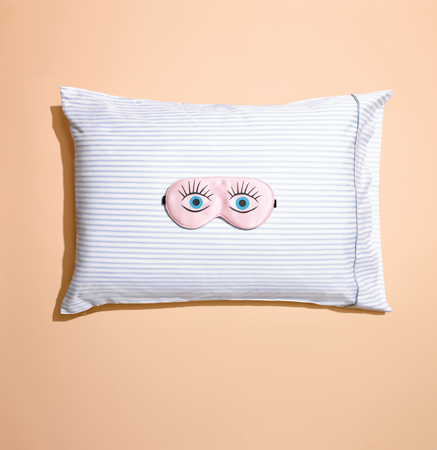
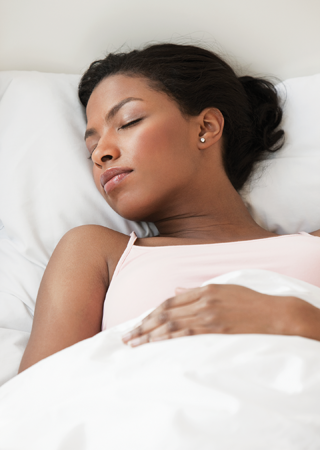
Reclaim Your Peace and Quiet
You’re alive during the noisiest period of human history, and it’s having powerful effects on your body, mind, and mood. Happily, you can turn down the volume.
By Florence Williams
This morning, as I often do, I walked with my dog by the Potomac River along a pretty stretch managed by the National Park Service. Both of us watched a pair of nesting mallards, and I spotted a couple of hawks circling overhead. A great blue heron flew by, all gangly and prehistoric. It could have and should have been a blissful moment of repose from D.C.’s urban frenzy. But above the hawks was a disruptive blast of low-flying commercial airplanes, interrupted only by the heart-shaking thumps of a helicopter.
Noise is defined as unwanted sound, and modern life is full of it. The world’s background-noise levels are likely louder now than at any point in human history. More of us live in urban areas—half the population of the planet—and with us comes our worldly din. Suburbs and rural areas have hardly escaped: Traffic on U.S. roads has nearly tripled in the past 30 years, and the number of passenger planes keeps rising and is expected to increase by as much as 50 percent by 2032.
I never knew how much noise bothered me until I moved from the Rocky Mountains to D.C. several years ago. Even though my new city is filled with greenery, parks, and trails, it’s hard to escape a pollutant that is both invisible and pervasive. Above my medium-density neighborhood, more than 800 aircraft fly every day to and from Reagan National Airport. I notice the airplanes the most but also the sirens, service trucks, and construction equipment, not to mention all the sounds of competitive lawn maintenance.
I often feel on edge, like it is hard to take a truly deep breath. Peace and quiet—as well as the sweet sounds of nature—can be important to achieving true relaxation. As Erling Kagge, the polar explorer and author of the forthcoming Silence in the Age of Noise, puts it, “Silence in itself is rich. It is exclusive and luxurious. A key to unlock new ways of thinking…a deeper form of experiencing life.” Kagge knows silence; he once spent 50 days plodding around Antarctica by himself.
Because I was interested in learning more about how my new urban environment was affecting my well-being after my move, I borrowed a portable brain wave–
monitoring device for my head and started wearing it around like a crown of thorns. My kids tried to steal it because of the cool sensors. The neighborhood dog walkers cut me a wide swath. I persevered.
I wanted to see how my brain was responding to all the noise around me. So I wore the machine along the Potomac trails, but my nervous system was too busy noticing the jets. The device’s software spit out an interpretation of my mental state: “This indicates that in this state you were actively processing information and, perhaps, that you should relax more often!”
That’s the thing about noise. It demands high-powered effort on our part, both to interpret it (is it a threat?) and to block it out. It’s one of the great unsung reasons that modern life takes a toll on us. And it’s a bigger one than most of us think. Unwanted noise is harder to block out than unwanted sights. We hear things even when we sleep.
I’ve noticed that not all my neighbors are as annoyed as I am.
“I don’t even notice the planes,” says Lauri Menditto, who has lived here for 20 years. Another neighbor, Nick Keenan, has a theory: There are two kinds of people—those who become increasingly sensitive to noise and those who learn to tolerate it. Some people download apps that play sounds that connote nostalgia, like train horns. It’s hard to imagine anyone would actually want to listen to low-flying jets, however.
It turns out Nick is partly right. Many of us can become habituated to noise, at least somewhat. But there is a hard-core minority, about 20 percent of people, who will remain irritated by loud, common sounds. We are more sensitive to stimuli. And some of us are so annoyed that we go to extremes. Consider the case of 82-year-old Pennsylvanian Frank Parduski Sr., who reportedly ran out to confront an offending motorcyclist, only to be run over. New Scientist magazine called the poor fellow “the world’s first anti-noise martyr.”
Ted Rueter is another of The Annoyed. Rueter, who suffers from noise-related headaches and fatigue, once boldly bought a neighbor an outdoor sweeper, a quieter alternative to a leaf blower. He delivered the gift with brownies. But his neighbor returned the offerings, and the near-daily gas-powered lawn care continued unabated. When Rueter left the University of California, Los Angeles, where he taught political science, he decided to take up the cause. Now he runs Noise Free America, a North Carolina–based coalition of dozens of citizen groups working to strengthen regulations and enforcement around the nation.
“Noise definitely wears me out,” he says. “I think a lot of people are of the belief that noise is a nuisance we have to live with rather than a significant health problem.” It can be a hard battle to wage, he says, because it’s a pollutant you don’t see. Nor do you see the damage, as you would smog or a dirt-clogged river.
I feel Rueter’s pain. These days the suburbs, especially if they’re leafy, can be just as loud as urban areas. Leaf blowers, along with lawn mowers, circular saws, surveillance helicopters, and the omnipresent planes, regularly impinge on my home-office shed, which has a roof about as thick as a sardine tin. Leaf blowers, I learned, can spin screamingly fast—up to about 8,000 rpm. Their high, whining pitch is particularly grating, falling somewhere between a baby with colic and a table saw approaching your cranium.
Hearing develops before vision in the womb. It is our dominant sense when it comes to sudden threats. It tells us something is out there and from which direction it’s coming, triggering our strongest startle reaction. In fact, mammalian ears can be incredibly sensitive. When Carl Linnaeus was deciding what to call our class of animals in 1735, he had a few unique characteristics to name us after, including our mammary glands and our fine inner-ear structure. Clearly he was a boob guy.
Our three delicate ear bones, our eardrums, and our pinnae—the hairs that deliver vibrating molecules into the brain, where they are processed as “sound”—may have evolved in early mammals in part to help them locate insects for food. This may be why human ears today are especially tuned to high-pitched sounds like mosquitoes and, yes, leaf blowers.
Health experts have long been concerned about noise because of its threat to hearing. Loud noises, whether at chronic levels over time or in sudden bursts, damage the pinnae, leading to permanent hearing loss. Across the U.S., a quarter of adults ages 20 to 69 show signs of noise-induced hearing impairment, and a recent study in Ireland found that one in two millennials shows early signs of hearing loss, mostly from excessively loud music in their headphones. Hearing is one of our great superpowers, and yet we are cavalierly giving it up.
Sound is measured in decibels (dB), and the scale increases logarithmically, so that 65 dB is 10 times as loud as 55 dB and 100 times as loud as 45 dB. Sixty decibels is high enough to drown out normal speech, and anything over 85 dB (such as busy city traffic) can damage hearing over time. The airplane noise in my neighborhood logs in at about 55 dB in an average 24-hour period, but individual planes can spike much louder, sometimes at 5:30 in the morning. This significantly exceeds the World Health Organization’s recommended limit of 40 dB at night to prevent sleep disturbance.
If you think noise doesn’t bug you, research suggests you may be fooling yourself. Studies show that even when people sleep through loud noises, their nervous systems are still responding as if preparing to wake and run if need be. This takes a toll.
“What we’re learning from quite a lot of studies is hearing loss may be just the tip of the iceberg,” says public health expert Richard Neitzel, associate professor of environmental health sciences at the University of Michigan in Ann Arbor. “As more research comes out, we see associations with heart attacks and high blood pressure, and guess what: That’s what kills Americans most. We are ignoring this at our peril. Noise is not just a nuisance to be accepted as a by-product of modern life. It can be just as bad for us as other pollutants we’ve been regulating, like ozone and particulate air pollution.”
Sound gets delivered to deep parts of our brain that are connected to the centers for fear and arousal. With enough rumbles and roars, our nervous systems can become stressed out over time, says Neitzel. This is why people living in noisier neighborhoods have up to a 17 percent higher risk of cardiovascular diseases, including stroke and hypertension. Old and young people seem to be especially at risk. Scientists have also found associations between increasing noise levels and the release of stress hormones.
Alarmingly, more than 20 studies have shown that noise pollution can affect children’s learning outcomes and cognitive performance. Some children in the Netherlands and the United Kingdom whose schools sit under flight paths or near busy airports show poorer reading comprehension and memory than children at quieter schools, even after adjusting for income and parental education. In fact, for every five-decibel aircraft-noise increase, the reading scores dropped by the equivalent of a one- or two-month delay.
All of which leads to the question, What is a city or suburb dweller to do? It turns out, people have been asking this question for a long time. Many of the loudest city sounds come from vehicles, which was true even before the dawn of cars and trucks. Ancient Rome was said to have banned chariots at night. The Founding Fathers in Philadelphia had the cobblestone streets covered with dirt lest their important work be disturbed.
In 1907, Manhattan socialite Julia Barnett Rice founded the Society for the Suppression of Unnecessary Noise. Its main campaign was focused on tugboats, which blew their horns more than 1,000 times a day. Mark Twain was an early supporter. Unlike the airport activists in my neighborhood, Rice was successful: Congress passed legislation restricting horn blowing.
But then came the wider use of the automobile, and city noise was to grow and not stop. Soon the car cacophony was joined by sirens, jackhammers, skill saws, leaf blowers, airplanes, helicopters, and subways.
Today Guangzhou, China, is the loudest city in the world, followed by Delhi, Cairo, and Mumbai, according to research compiled by the World Health Organization and Mimi, a hearing-technology company. The quietest cities all lie within Europe: Zurich, then Vienna, Oslo, Munich, and Stockholm. That’s because the European Union takes noise seriously, both funding research into health effects and regulating industrial equipment to protect workers from hearing loss. Germany even discourages lawn mowing on Sundays. (Though between runway expansions and an increasing number of flights, the airports in Europe are still a source of irritation for many residents.)
Thanks to the federal deregulation movement in the 1980s, the United States follows a much more local—and often lax—approach to sound regulation. This is why, says Rueter, it’s so important for citizens to speak up and defend their right to relative peace. A number of communities, including Los Angeles and other cities in California, have successfully lobbied to ban gas-powered leaf blowers. What has replaced them? Battery-powered ones, which are improving in power and are several orders of magnitude quieter.
Airport noise here, as in Europe, is harder to tackle. Santa Monica, California, is scheduled to close its airport after 2028. The posh resort town of East Hampton, New York, logged more than 30,000 noise complaints against its airport in 2015. But when the town tried to impose nighttime curfews on flights, a federal appeals court ruled that the town had to obtain Federal Aviation Administration approval first. East Hampton lost its bid to go to the Supreme Court in June, 2017, but local officials plan to keep working on the noise issue.
That won’t be happening in my hometown anytime soon. After reading the European health studies, I installed a decibel meter app on my phone. To my children’s amusement, I now sometimes run around, phone outstretched, measuring the noise levels in and out of the house. Distressingly, they are similar to levels associated with hypertension and learning delays. Apart from moving, there are some steps we can take. I often wear noise-canceling headphones while working at home. I tell my teenagers, frequently, to turn down their music and protect their ears. But, being teenagers, they tend to wave me off. In this they are not unlike most Americans when it comes to auditory concerns.
Perhaps we have ignored noise pollution for so long because we are visual creatures, suggests Colorado State University postdoctoral researcher Rachel Buxton, PhD. She’s been studying the detrimental effects of noise on the mating and feeding patterns of wildlife, including birds. She’s also been mapping and modeling sound throughout the nation. Despite the problems she sees and the steady growth of noise over time, she’s optimistic: “We have the technology and methods to manage noise pollution.” She points to recent innovations like “quiet pavement” that muffles traffic noise, quieter home and yard machines, and strategies to consolidate aircraft noise over roads. Peer pressure helps, too. In Muir Woods in Northern California, the National Park Service simply put up signs designating a quiet zone around the biggest, most majestic trees. “And people listened,” she said. “No pun intended.”
Neitzel from the University of Michigan thinks we may have reached Peak Noise. Soon, he hopes, we will read the studies, come to our senses, and start enforcing reasonable limits to find peace once again.
In the meantime, I will keep searching for peace on my own. On a recent short vacation in Maine, I woke up very early and headed down to a small, hill-rimmed lake. I clamped down the EEG cap and slid into a kayak. Paddling through a foot of soft mist resting on the water’s surface, I headed across, toward a generous expanse of the White Mountain National Forest on the far shore. I couldn’t see my blade, but I could hear its drips, as well as the birds of morning along the shadowed woods. A few jets flew overhead, but they seemed very far away. I filled my lungs with the moist air and the sun and the birdsong, and I gently floated the boat along.
Once I returned and uploaded the data, I got this message: “Even with your eyes open…you enter a relaxed state very easily.”
Finally I had tricked the machine into thinking I was some sort of bodhisattva. For a few moments on a quiet lake, I was.
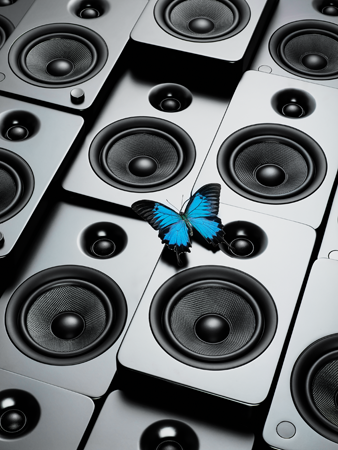
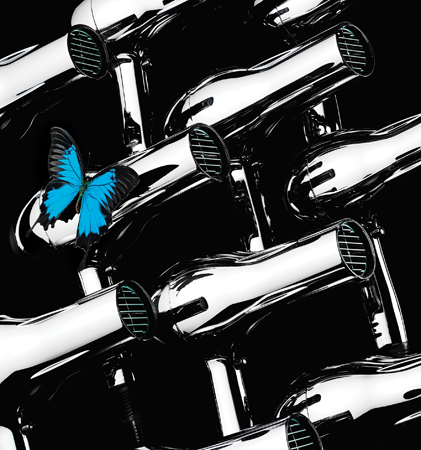
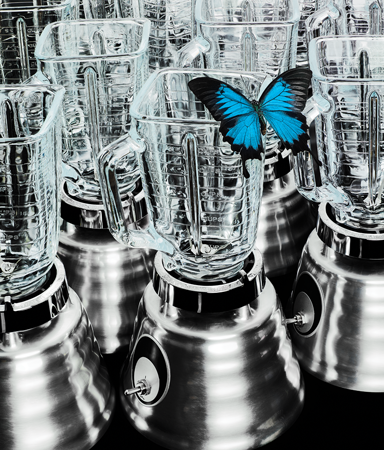
Know your Noise
Sounds don’t have to be deafening to cause harm—especially if you’re subjecting yourself to the sounds of a hair dryer, a leaf blower, and a Zumba class all in the same morning. Here’s how to protect your ears and your sanity.
By Kate Rockwood
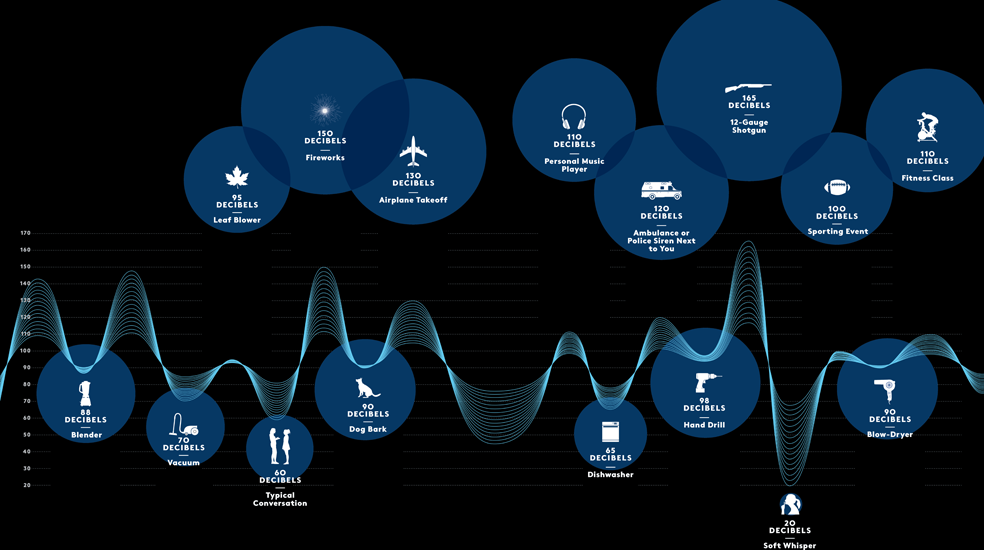
88
DECIBELS
Blender
Your blender can whirl for four hours before hurting your eardrums. That may seem like an inconceivable number of smoothies until you consider that many household sounds hover at this level. Don’t cram more than four hours of noisy tasks into one day. As for blenders, some models, like the Jamba Quiet blender ($140; target.com), have plastic enclosures to mask sounds.
70
DECIBELS
Vacuum
If you’re bothered by the din of your vacuum, swap it for the Electrolux Silent Performer Cyclone Vacuum ($300; electrolux.com).
95
DECIBELS
Leaf Blower
Just seven minutes of operating the average gas-powered leaf blower without covering your ears can affect your hearing. Opt for a rake or a leaf blower that runs on electricity or batteries, which tends to be quieter. The EGO 530 Cordless Leaf Blower ($132; homedepot.com) claims to be the quietest on the market, at 65 decibels.
60
DECIBELS
Typical Conversation
“As long as no one’s yelling, you can engage in conversation nonstop and not harm your hearing,” says Cristina Cabrera-Muffly, MD, an otolaryngologist and assistant professor at the University of Colorado in Denver. But if you’re raising your voice or leaning closer to hear, those are red flags that you should take your talk elsewhere.
150
DECIBELS
Fireworks
Fireworks are loud enough to affect your hearing with just one kaboom from a few feet away. Grab your earplugs and head for the farthest lawn seats at the next display. The more distance you can put between your ears and the detonation, the better.
90
DECIBELS
Dog Bark
At max exertion, dogs can hit triple-digit decibels, but studies show that sustained barking is usually closer to 90.
130
DECIBELS
Airplane Takeoff
Runway workers wear ear protection for a reason. Listening to a jet take off 100 feet away can cause permanent damage in seconds. If you’re boarding a plane outside, cover your ears. That won’t totally protect you, but it will help.
110
DECIBELS
Personal Music Player
You can listen to most headphones at top volume for only about eight minutes before it affects your hearing. Ask a friend to talk at a normal level: You should be able to hear her over the music. And wear noise-canceling headphones. We like Sony’s MDR-1000X headphones ($350; sony.com) and BeMe D200 earbuds ($140; beemunited.com). Keep the volume dial below the halfway point.
65
DECIBELS
Dishwasher
At this level, your appliance won’t hurt your hearing. But if you want to cut back on noise in the kitchen, the Samsung Top Control Dishwasher with Flextray ($1,200; homedepot.com) can hum at as low as 38 decibels, reportedly the lowest on the market.
120
DECIBELS
Ambulance or Police Siren Next to You
Being inside a car will muffle the noise somewhat. Still, if that emergency vehicle isn’t speeding past fast enough or you’re on the sidewalk, it’s smart to cover your ears.
98
DECIBELS
Hand Drill
Though they’re small, hand drills pack a big punch when it comes to noise. The Black + Decker 12V MAX Cordless Lithium Drill and Driver ($43; target.com) can provide some relief.
165
DECIBELS
12-Gauge Shotgun
A shotgun blast at close range can cause permanent damage after a single fire, which is why so many sport shooters wear noise-canceling earmuffs. Howard Leight’s Impact Sport Electronic Earmuffs ($43; homedepot.com) block out sounds at hazardous levels.
20
DECIBELS
Soft Whisper
Whether it’s pillow talk or a funny stage whisper, if you can’t hear at this volume, it’s time to get your hearing checked.
100
DECIBELS
Sporting Event
“If you have ringing or buzzing in your ears after a loud event, call an ear, nose, and throat specialist,” says Cabrera-Muffly. Docs aren’t sure why it works, but a dose of steroids from your doctor soon after an event may ease inflammation in the ear and prevent further damage.
90
DECIBELS
Blow-Dryer
“How close you are to the sound affects how damaging it is, and with a hair dryer, that noise is right next to your ear,” says Jennifer Phelan, an audiologist and clinical instructor at Northwestern University. Download the Decibel 10 app to test your dryer’s level and consider swapping it for a quieter model, like the Dyson Supersonic Hair Dryer ($400; dyson.com).
110
DECIBELS
Fitness Class
“It’s ironic that we go to the gym to get healthy but may be damaging our ears,” says Sarah Sydlowski, PhD, an audiologist at the Cleveland Clinic. “If you have to raise your voice to talk to the person next to you, the environment is likely too loud.” Talk to the manager, sit away from the speaker, or wear noise-reducing earplugs, like LiveMus!c’s HearSafe Earplugs ($29; amazon.com).
Ahhh…
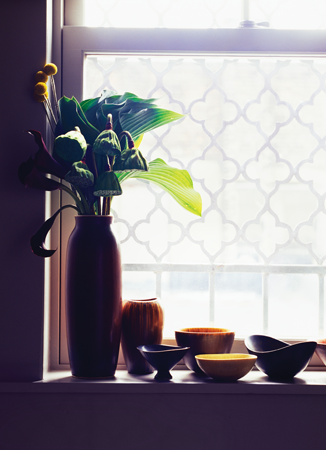
Here’s a sound meditation you can do anytime to feel less stressed and more open: Sit quietly and relax your jaw, face, and tongue. Close your eyes; imagine your ears opening. Begin to notice the sounds around you. Now pick just one of those—a ticking clock, say, or your dog’s snoring—and follow it for a minute or so. Then let it go and focus on a different sound—the wind blowing outside, for example. Give that a few moments’ attention. Do the same with a third sound. Finally, take a deep, easy breath and let all the sounds around you come into your ears at once. The result: You might appreciate that all sounds come and go—those you like and those you find annoying—and that you can be stable and relaxed no matter what your ears are taking in.
—CYNDI LEE, cyndilee.com
Hold That Pose
It’s crucial to staying fit and injury-free. Improve your balance with these simple strength-plus-stability moves.
By Sheila Monaghan
Can you hop on one foot? Walk on a beam? Sit on a ball without toppling over? These exercises may sound like child’s play, but they’re actually sophisticated movements that build up physical balance, a skill that’s essential well into adulthood.
Balance might not have the cachet of flat abs, but it’s remarkable all the same: the result of your brain, eyes, sense of touch, inner ears, and every joint and muscle in your body working in concert. Great balance means great posture, whether you’re sitting still, running, or lifting a weight. When you’re balanced, left and right, and front and back, are exerting equal effort. No one part of the body is overcompensating for another, and because of this “you suffer from fewer aches and pains,” says Jordan Metzl, MD, a sports-medicine physician at the Hospital for Special Surgery, in New York City, and the author of The Exercise Cure.
It also makes you less accident-prone. In one study, researchers at the University of Michigan, in Ann Arbor, wired people with typical balance ability to electrodes and sent them walking on (and falling off) a narrow beam affixed to a moving treadmill. Turns out, when those with good balance start to fall, the sensory motor cortex of the brain (the area that receives and interprets sensations) immediately registers that the body is no longer steady. Neurons that track errors, navigation, spatial orientation, planning, and regulation also become instantly activated, while the eyes suss out the body’s new position and how fast it’s moving in space. The muscles react and right themselves before you hit the floor. You have roughly 250 to 400 milliseconds to catch a fall, says Daniel Ferris, PhD, the study’s lead author. But those who are wobbly may not be able to avoid a spill: According to the Centers for Disease Control and Prevention, falls are the leading cause of nonfatal injuries in the United States.
Granted, 50 to 75 percent of your ability to balance depends on genetics. But that leaves 25 to 50 percent that can be cultivated through plain old hard work. Whether your goal is mastering that inverted yoga pose or simply avoiding slips in an icy parking lot, you need a two-pronged approach: training your brain and muscle reflexes so that they detect and react to unstable situations quickly; and conditioning your core (abdominals, pelvis, hips, and lower back, which form the center of gravity that stabilizes your body) so that the reaction is controlled, says Kai Wheeler, a San Diego–based personal trainer.
Everyday Habits to Stay Steady
Building balance is like learning to play an instrument. “You need to create appropriate neuromuscular connections—that is, links between your brain and muscles. Then you need to practice to keep those connections from deteriorating,” says Jonathan Cane, an exercise physiologist and the founder of City Coach Multisport, an endurance-training service in New York City. Older people often have poor balance because they’re sedentary and therefore rusty. Children, in contrast, have wonderful balance because they train every day: experimenting with unstable positions—playing hopscotch, riding a scooter—then bolstering neuromuscular pathways as they grow skilled at those activities, says Metzl.
Fortunately, adults can sneak balance work into their all-work-and-no-play schedules. All these ideas help to strengthen your core or challenge your reflexes—or do both.
WHEN YOU’RE WALKING: If you’re on a semiquiet street (no buses whizzing by), try stepping along the curb instead of the sidewalk.
WHEN YOU DROP A SMALL OBJECT: Pick it up while keeping one leg elevated behind you. As you improve, challenge yourself by lifting the leg higher.
WHEN YOU’RE WATCHING TV: Sit on an exercise ball instead of the sofa. Start with a half-hour sitcom, then gradually build up to a Netflix marathon.
WHEN YOU’RE HAVING A MEAL: Pull the chair up to the table as close as you can, says Mary Helen Bowers, the founder of Ballet Beautiful, a dance-based fitness studio with online streaming workouts: “This pushes you to sit up straight and pull your center in, actively engaging your core.”
WHEN YOU’RE ON A TRAIN: Stand with a wide stance, knees slightly bent (as if you were surfing), without holding a railing. Engage your core and leg muscles to help keep from falling over.
WHEN YOU’RE BRUSHING YOUR TEETH: Stand on one leg, suggests Metzl. Switch sides every day.
Five Moves for Strength and Balance
What do a snowboarder, a gymnast, a ballet dancer, a circus acrobat, and a surfer have in common? They all have impeccable balance. And they’re all part of the team that Real Simple assembled to create this full-body balance-strengthening regimen. Combine these five exercises into one routine and you’ll be training your brain and conditioning your core to stabilize you in all planes of motion: forward and backward, side to side, and rotationally. Practice two to three times each week to build muscle memory.
Move 1
Kneeling Alternating Superman
Recommended by Gretchen Bleiler, Olympic snowboarder.
WHAT IT WORKS: Upper back, core.
HOW TO DO IT: Get down onto your hands and knees. Lift and extend your left arm forward as you simultaneously extend your right leg behind you. Hold for five counts. Repeat with the opposite arm and leg. Alternate sides for five reps on each side.
TIP: “Up the difficulty by raising the stabilizing foot off the floor, so only your hand and knee are keeping you steady,” says Bleiler. “Watch yourself in the mirror. Your back should be flat like a table; do this by squeezing your core and keeping your shoulders down and back. And your hips should be straight, not rotated, even as you raise your leg.”
Move 2
DIY Balance-Beam Routine
Recommended by Jordyn Wieber, 2012 Olympic gold-medal-winning gymnast.
WHAT IT WORKS: Core, quadriceps, hamstrings, calves.
HOW TO DO IT: Create a 10- to 12-foot line on the floor with painter’s tape. Walk along the line on tiptoe back and forth, with arms extended to the side. Next, for 30 seconds, stand on one leg (stay on your toes) with eyes closed. Repeat with the opposite leg. Now jump in place 10 times, with one foot in front of the other, as if on a balance beam.
TIP: “To challenge yourself further, stand on one leg—with your foot flat, or on tiptoes as your balance improves—and lift the other leg straight back into the air with your arms extended out to the sides. Hold it for 30 seconds, then switch legs and repeat,” says Wieber.
Move 3
Standing Abs
Recommended by Mary Helen Bowers, former dancer with the New York City Ballet.
What it works: Core.
HOW TO DO IT: From a standing position, bend your right knee and extend your left leg behind you, keeping your upper body elongated. Extend your left arm up and over your head as you lean your torso to the right, keeping your right arm down. Pulse for a count of 16. Return to the standing position, core centered, and straighten your knees. Repeat on the other side.
TIP: Pull your abdominals in tightly as you lift your arm over your head; don’t be afraid to bend as far as you can. “You’ll feel your muscles pulling and stretching through the side and the core,” says Bowers. As you grow more adept, add in more repetitions and a deeper side bend.
Move 4
Varied-Width Push-Up
Recommended by Elena Zhirnova, performer with Cirque du Soleil.
WHAT IT WORKS: Shoulders, chest, upper back, core, wrists.
HOW TO DO IT: Get into a modified push-up position (hands and knees on the floor), then cross your ankles and position your hands directly beneath your shoulders. Lower your body to the ground for as deep a push-up as possible, then push back up to the starting position. Do five repetitions, then do five more with your hands wider than shoulder-width. This will target different muscle groups. Repeat twice.
TIP: “After about a month of this exercise, try a more advanced push-up position with your knees straight and your toes on the floor, as in a full-on push-up,” says Zhirnova, who specializes in aerial acrobatics and hand balancing. If you’re working toward doing a handstand, try changing your arm and hand positions so that your index fingers and thumbs form a diamond on the floor. This works additional arm muscles.
Move 5
Medicine-Ball Toss
Recommended by Erica Hosseini, former professional surfer.
WHAT IT WORKS: Chest, back, arms, core, obliques, legs.
HOW TO DO IT: Sit on an exercise ball, holding a three-pound medicine ball in your hands. Rotate your trunk to the right, then return to the center and toss the ball up lightly and catch. Repeat on the left. Do four reps on each side.
TIP: Straighten your spine, squeeze your core, keep your shoulders down and back, and look straight ahead. For a harder workout, says Hosseini, try kneeling on the ball for eight counts. When you find your balance, you can gradually add the ball toss and twist.
